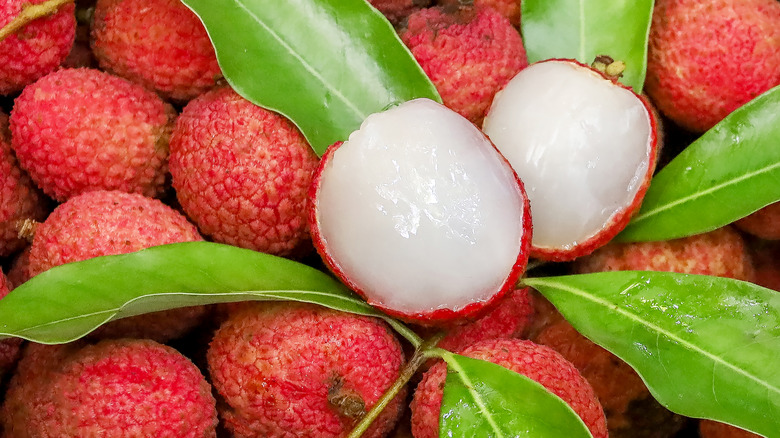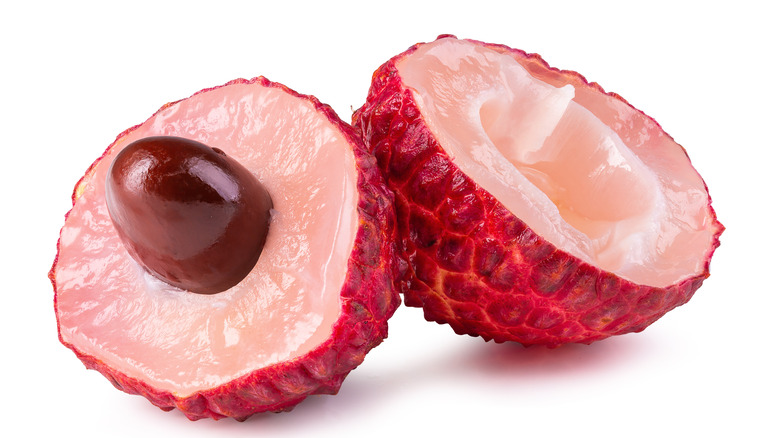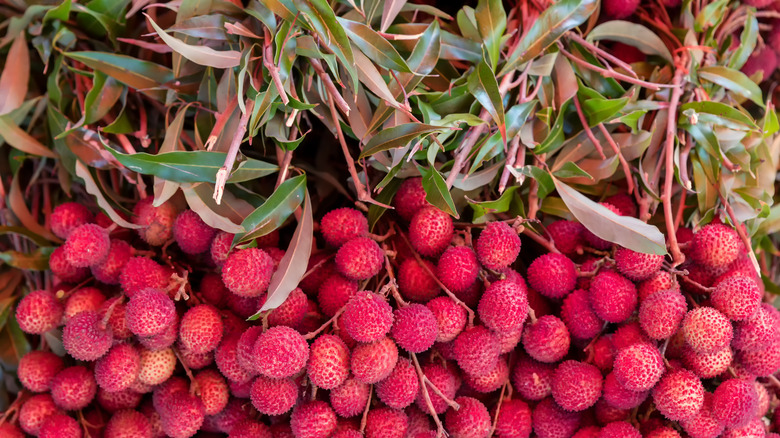What Is Lychee And How Do You Eat It?
There are many reasons to thank the food gods for modern shipping and refrigeration. One such reason is because it gives us access to fruit that we would have been otherwise unable to see, taste, or enjoy in the comforts of our own home. It's how many of us can enjoy the lychee.
The small, bumpy red fruit known as the lychee is happiest in the tropics, and while it can mostly be found in parts of South East Asia, it is commercially cultivated in both China and India. Globalization has allowed the lychee (or litchi as it is known in some places) to spread its roots as it were, so it is now grown in the continental United States — specifically Florida, where lychees have grown since 1916 — and in other parts of the world including the Mediterranean, South Africa, and Hawaii, according to Britannica.
The lychee is closely related to the longan, a small, brown-shelled fruit widely cultivated in Thailand, and the rambutan, a fleshy white fruit which, like the lychee, is covered in a red, spiky peel. Once they become ripe, lychees need to be kept refrigerated so they can last longer; without the cold, lychees can only survive room temperatures for up to three days (via Know and Enjoy Tropical Fruit).
How do you eat fresh lychees?
If you're lucky enough to find lychees at your local supermarket, make sure you select fruits that are larger than an inch and have a brightly-colored husk similar in appearance to alligator skin. Most lychees are a dull red, although some can be orange or pinkish. Because they don't ripen after they are picked, it's important to buy lychees that are ready to eat. Press the fruit gently and if it is firm but not solid, your lychee is good to go. Give soft lychees, oozing lychees, or lychees with cracked skins a hard pass — those aren't likely to be edible (via The Spruce Eats).
You can crack open a lychee the way you might do a peanut, by squeezing it gently over a bowl to catch any falling juices and then peeling back the rind like you would peel a tangerine. You can choose to nibble on the lychee after it's been peeled and then discard the pit, or cut through the fruit to reveal the stone, discard that, and enjoy.
If all this sounds like too much work for you, lychees can also be purchased vacuum sealed or in a can, and can be frozen or dehydrated to extend their shelf life (via FoodPrint). But as with most fruit, there's nothing like enjoying it fresh.
Lychees are nutritious, but they also have a dark side
At their core, lychees are mostly water (82%) and carbs (16.5%), but Healthline says a 3.5 ounce serving of the fruit also contains 66 calories, 0.8 grams of protein, 16.5 grams of carbs, 15.2 grams of sugar, 1.3 grams of fiber, and 0.4 grams of fat, but don't let that fool you, because it also punches above its weight to deliver on vitamins (one small lychee offers up 9% of your recommended vitamin C for the day — and who can stop with one?), copper, and potassium, which is critical for heart health. The fruit also has plant compounds epicatechin and rutin, which are antioxidants that may help your body in the fight against cancer and chronic diseases like diabetes.
But while lychees may be healthy when they at their peak, they can be a health hazard when they aren't — particularly to those who might be under nourished or who are eating less-than-ripe lychees on an empty stomach. Unripe lychees contain a compound called hypoglycin which can curb the body's ability to produce glucose, which can, in turn, induce hypoglycemia or low blood sugar (via Proactive Health).


